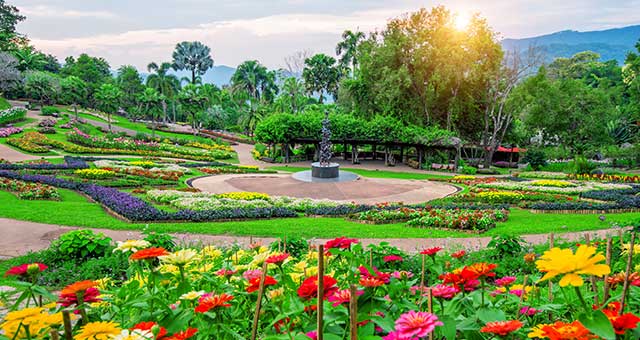
Tips To Make Your Landscaping Look Great This Summer
Our gardens and lawns are natural extensions of our homes. They are generally the first thing that guests notice. Beautiful landscaping exudes a pleasant, welcoming atmosphere. If your garden and yard look less than perfect follow these easy landscaping tips to create a thriving, beautiful outdoor oasis this summer.
1. Use Water Wisely
During the hot summer, you will need to water your landscaping a little more than average to keep it healthy and green. However, you do not want to waste that water, so make sure you have a strategy. Irrigate it three times per week in the morning with plenty of water.
Watering your landscape early in the morning permits the soil to efficiently absorb water (and later the sun will evaporate it!) and the grass to go through photosynthesis. If you water at night, the lawn will not be able to effectively use the water it receives as photosynthesis requires sunlight. Also, the colder air and calmer winds in the morning provide enough opportunities for the soil to absorb water, keeping your lawn hydrated throughout the day.
Watering your lawn late at night encourages the formation of fungus in damp soil and roots do not have enough time to remove surplus water. If your grass has already turned brown, utilize drip irrigation to help it absorb more water in preparation for the fall season.
2. Mow The Lawn Frequently
During the spring and summer, mowing your lawn at least once a week is a key to keeping it in good shape. The grass should be mowed to a height of 2.5 to 3 inches. This length will provide the necessary heat protection and aid in hydration retention. This contributes to an environment that is more resistant to environmental stress, grass disease, and insects.
Further, unless your lawn has a problem, leave the grass clippings on after you mow, as they offer nutrients, organic matter, moisture, potassium, and nitrogen to the soil. However, if you reside in an HOA community check the policies. You may not be allowed to leave grass cuttings in your yard.
3. Defend Against Pests
Pests may wreak havoc on your landscaping during the summer. If you discover a problem, prepare a strategy to address it as soon as possible. If the plants are being eaten by specific bugs, make sure to use a natural organic insecticide.
Some plants can also be your pest-repelling hidden weapon. Natural insect repellents include lemongrass, garlic, rosemary, and basil, while marigolds can keep squash bugs and tomato worms away from your garden.
Also, ensure that any pest control you use to kill the bugs does not harm the pollinators like bees, hummingbirds, and butterflies as they are vital to the general health of your garden.
4. Choose The Right Plants.
Choosing the right type of plants is a significant part of summer landscaping success. Consider including native flowering perennials (like roses and mums) in your landscaping mix to make gardening less challenging.
These native plants require less fertilizer and water. So, even if it is scorching summer, you would not have to work hard to keep your landscaping alive. Also, perennials renew every spring, so you need not replace them every year. However, as these flower for a shorter amount of time than annuals, many gardeners opt to mix the two types of plants in their gardens.
Further, if you have enough room, planting shade trees may be a good option as it will make your yard more comfortable during the hot summer days.
5. Keep Your Plants Safe.
Re-mulching your garden beds in the summer is a great idea. Laying down a layer of organic mulch will reduce water evaporation, lower soil temperature, and inhibit weed development. Add a 2 to a 3-inch thick layer of soil to any bare patches of soil around your plants. However, leave the areas immediately surrounding tree trunks and plant stems uncovered, since moisture can build up and cause rot.
Mulch also helps to maintain cooler soil temperatures, reducing the demand for watering. However, remember to keep an eye on the weeds! Weeds siphon off water and nutrients from the soil, leaving your plants thirsty. Weed at least twice a month and once a week for optimal effects.
Bottom Line
These are just a few summer landscaping ideas. Just remember to have a good time! Landscaping and gardening are wonderful ways to enjoy the outdoors while also adding natural beauty to your surroundings.


